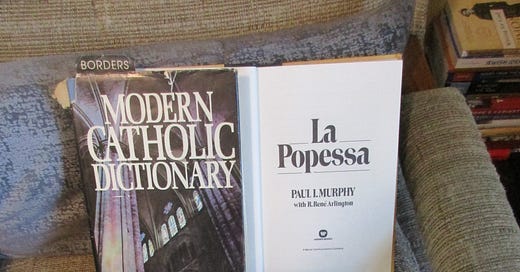I’m reading many things, but I’m unsure what to write about. I have ideas.
Pascalina/Pius XII/Cdl. Spellman: I just finished the fascinating biography of Sr. Pascalina, confidante to Pius XII: La Popessa by Paul I. Murphy (with R. Rene Arlington), (NY: Warner Books, 1983). Pascalina, a German nun, was a woman of great power who confounded many in the hierarchy and was zealously protective of Pope Pacelli. It is a gossipy book and a bit loose in its use of details. Just one example: Murphy ( a close collaborator with Cardinal Cushing) covers the spat between Cardinal Spellman and Bishop Fulton Sheen. He mentions that Sheen was exiled to the Diocese of Rochester after the spat, which is true…but didn’t happen until 1966, about ten years after the events depicted in the book and eight years after the death of Pius. I am now interested in learning more about Spellman. (I have a biography of him, The American Pope, on the way.) Murphy dishes on how Spellman was a topnotch money raiser and investor in some puzzling businesses and prime real estate. This naturally led me to think of Robert Moses, the unparalleled public planner and builder in New York for decades, and the subject of massive biography by Robert Caro, The Power Broker: Robert Moses and the Fall of New York (NY: Alfred A. Knopf, 1974). There are a number of references to Spellman in that book and the two worked together to the extent that Moses was derisively called “Spellman’s pet Jew.” (As an interesting side note, the story of how thinker-activist Jane Jacobs helped thwart the destruction of a Manhattan neighborhood by a Moses road project is engagingly told in Anthony Flint’s Wrestling Moses: How Jane Jacobs Took On New York’s Master Builder and Transformed the American City (NY: Random House, 2011). Jacobs’ theories have made our cities much more human, walkable, and pleasant.) Another angle in this story is how Catholic Worker co-founder Dorothy Day clashed with Spellman more than once, including when he went to war on a group of diocesan cemetery gravediggers.
Elizabeth Gaskell: I recently finished her superb novel, Wives and Daughters (Ware, UK: Wordsworth Classics, 2003). She builds on the class and manners and love novels of Jane Austen and mostly avoids the raging romanticism of the Bronte sisters. There are beautifully-drawn characters here, coupled with the devastation inflicted by gossip, humor, and the results of staying to true a moral compass. I have watched “North & South” and “Cranford.” But it was a pleasure to read Mrs. Gaskell for the first time. Robert lazu Kmita has written more than once about the BBC version of “Wives and Daughters” but it is hard to find (except on DVD, I think).
Four Jewish Women: I want to write something about the ladder to Christ as lived out by four important Jewish thinkers who just happen to be women: Ayn Rand (who turned her back on God and created a gospel of individualism, greed, and materialism); Hannah Arendt (who was not religious but counted St. Augustine among her intellectual guides); Simone Weil ( a mystic attracted to God and the Catholic Faith but who was never baptized); and Edith Stein (who became a Carmelite and suffered death for her ethnicity).
Interdict: The interdict was a tool of the Church to draw back recalcitrant cities or states to the Faith. As Fr. John Hardon, S.J. writes in his Modern Catholic Dictionary (NY: Doubleday, 1980, 1979 imprimatur): “A censure forbidding the faithful, while still remaining in communion with the Church, the use of certain sacred privileges, such as Christian burial, some of the sacraments, and attendance at liturgical services” (283). Hardon (one of the good modern Jesuits) was a man of holiness, and this book is indispensable—I recommend picking up a copy if you find one. It is also available in a paperback version. I want to argue that the interdict should be dusted off and put to use in troublesome spots. Germany comes to mind.
The Middle Ages Saved Me From Liberalism: This is an essay I hope to get going on. (I have a few notes and bit of an introduction.) I was blessed to have excellent courses in the Medieval while I was an undergrad. Over time, that influence (along with Tolkien) helped steer me away from modernism and into Tradition.
Over at Hannah Arendt Was Right (my other Substack): I’ve been working through her dissertation Love & Saint Augustine and am up to her chapter on love of neighbor.
For an appreciation of Catholic art: I somehow received something from the delightful and thought-provoking Christian Art and Fr. Patrick van der Vorst.
I’m having trouble picking out my next novel to read; I just began Malachi Martin’s The Jesuits. Happy reading!





I was able to borrow a copy of the Wives and Daughters dvd at my local library. It was worth the watch. I would also recommend North and South by Gaskell, if you haven't yet read that. I have loved your recent pictures of your library! I have a smaller, but similar set up. I only keep books that I cherish-- or know that I should, lol! Thanks for your work here.